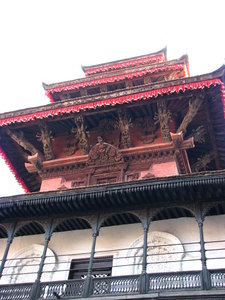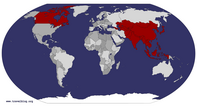Advertisement
Published: January 9th 2009

 Durbar Square
Durbar Square
Apparently the pagoda style rooftops was originally designed and developed by the Nepalese, and was later imported to China and JapanThe Nepalese Way
This was it. I woke up on Wednesday morning eager to fly solo at the Monastary that day. I had laboured diligently on my lesson plan the night before, creating flashcards and a detailed breakdown of the following day’s activities. I was ready to spread my wings and begin giving back to the community.
Lesson #2 from the Year of Jen: The world doesn’t follow the same clock or calendar.
At about the halfway point to Bodor, Helena got a call from our in-country coordinator to let us know that it was a school holiday that day and so we didn’t have any classes. It was 11am. Now, it would be unheard of back home for a teacher to be completely oblivious about a school holiday until she had arrived at an empty school, however it appears as though this kind of thing happens quite regularly here. After talking to the other volunteers, I learned that none of them have actually worked a full week at their placements, despite conscientiously showing up each day. The kids are certainly entitled to their holidays; however the mystifying part about the whole thing is that the in-country coordinators

 Sex Ed...Nepalese Style...
Sex Ed...Nepalese Style...
Take a look at the carvings at the bottom of all the support poles. Some of them are quite risque...do not appear to have any kind of calendar that indicates which days we have off. Do the holidays change from year to year? Are they completely arbitrary? Nobody knows…
Ignoring the inconvenience, we shrugged our shoulders, chalked it up to the Nepalese way, and jumped onto the next Tuk Tuk back into the city.
We decided to spend our newfound free time exploring Durbar Square, which is the heart of Kathmandu. We caught a Rickshaw from the Thamel district (my home neighbourhood for the next 2 weeks) to the square, as neither of us had any idea on how to get there. It was 150 rupees (which roughly translates into about $2) for the 20 minute trip. The rickshaw ride itself was mildly stressful; despite having a very considerate and careful driver. Helena rides horses back home and so is used to balancing on precarious seats. I, on the other hand, white-knuckled the holy-shit handle the whole way for fear of tipping out of my seat during a sharp corner or unexpected pothole.
We were only in Durbar Square for about 5 minutes before we were approached by a guide. Some vigorous haggling got him down

 View from Hippie Temple
View from Hippie Temple
Probably the only place in Kathmandu where you can successfully avoid the toots trying to sell anything and everything....to 250 rupees (each) for the privilege of his services. I don’t regret a single penny of the $4 I ultimately ended up paying him. His English was impeccable, his knowledge was impressive, and his passion for all things Nepalese was inspirational. He spent over 2 hours taking us through the square, explaining each temple and monument inside it. It was a bit of an information overload after awhile, and so in an attempt to remember as much of it as possible, I’ve decided to give a brief summary in my blog (some facts may be completely untrue as I’m basing this summary largely on my memory, with a little bit of help from the Lonely Planet):
Nepal: Until Prithvi Narayan Shah unified Nepal in 1769, the country was divided into approximately 40 separate countries, each with their own dialect, coin, and army. The mountainous geography of the country meant that each region was well-fortified against attack, from both outside the (now) country of Nepal, and from within the different regions. Unification did not occur until Prithvi Shah, a ruler of the hilltop kingdom of Gorkha (hence the famous Gorkha warriers), successfully invaded Kathmandu in 1768. Out of all

 Kumari - Living Goddess
Kumari - Living Goddess
Worshipped as a living goddess until she hits puberty - at which point she reverts to a mere mortal (albeit likely the world's most spoiled one)the regions within the country, the valley of Kathmandu, was the most difficult one for him to breach. In fact, the Kathmandu army had successfully turned back several invasions from Shah, until the ruler had the smart idea to sneak his army into the city while the inhabitants were drunk during the Indra Jakra festival. Shah moved his capital from Gorkha to Kathmandu and established the Shah dynasty which rules to this day. The national language of Nepalese was declared, however while everyone does speak this outside the home, the multiple dialects are still practiced today. It is estimated that approximately 86 languages exist in the country (although not all of them are officially recognized).
Kathmandu: The city was actually named after a wooden temple called Kashamandap (which I believe means wooden house). The buildings constructed in the Kathmandu valley were largely made up of wood and clay, and so it seemed fitting that the city within this valley was named after the structures within in. Durbar Square was where the kings were once crowned, legitimized, and ruled (Durbar means palace). Most of the square dates back from the 17th and 18th century and has been declared a UNESCO world heritage site.
Kashamandap: according to our guide, this temple was created from the wood of a single sal tree. In the center of the temple there is a monument to Gorakhnath where you can go to receive a blessing. I was pooped on by a pigeon right next to this monument, so who knows - maybe it is lucky. Around the four corners of the structure, there are images of Ganesh (the God of success and wellbeing). Apparently it is the custom to always pray to Ganesh first, regardless of whatever other Hindu God you want to worship. Ganesh has the head of an elephant, due to an unfortunate misunderstanding with his mother’s husband which resulted in his decapitation.
Hippie Temple: this is a multi-leveled temple in the heart of Durbar Square. Until 1947, the borders of Nepal were closed against outsiders. Tourism was prohibited from the country, resulting in very little being known about the people and customs of Nepal. When the country finally decided to open its borders to tourism in 1947, visitors came into the country with no idea of what to expect. In fact, many of the first visitors to Nepal arrived in full business suits, as they were uncertain about what construed as appropriate clothing for the country and wanted to dress to impress. The now booming tourist district of Thamel did not exist at this time (and was in fact farming land), and so the city life revolved around Dubar Square and Freak Street. Visitors came to the square and quickly realized that if they climbed up the steps to this temple, they were able to get high from the smoke of marijuana that drifted up to the top. The temple quickly became one of the most popular spots in the city, and it is rumoured that the tourists would stumble back to their hotel, change out of their business suits and into sheets, to climb back up the monument and party (hence the origin of Freak Street - as this behaviour was considered quite odd to the locals). Both Helena and I climbed to the top, but alas, the only thing we could inhale was the sweet scent of city smog. It did provide great views of the rest of the Square though, and was a great place to people watch.
Kama Sutra Temple: I’m not sure whether this is true, as it sounds far too outrageous, however I’ll write it down regardless. According to our guide, the city wanted to expand their armies so that they would be better fortified against attack. In order to do so, they needed the population to grow. And for that to occur, they wanted to promote and educate the people on sexual intercourse (intended for married couples only of course!). Several of the temples within Durbar Square are covered in carvings which depict erotic art - from conventional to quite risqué…I guess you could say that this was the Medieval Nepalese version of sex ed.
Kumari Bahal: This intricately carved house belongs to the Kumari, who is selected to be the city’s living goddess until she hits puberty, at which point she goes back to being merely a mortal girl. A new Kumari was selected last year, after passing the rigorous testing involved in selecting the candidates. These requirements include being from the Buddha bloodlines, being born under a full moon, having eyes like a cow (round and dark), having a pale round face, a body like a banyan tree, and being unafraid of the 108 buffalos and chickens sacrificed every year at the Indra Jakra festival. The girl is 3.5 years old and is only allowed to leave her home for 13 days every year during this same festival. She will remain a living goddess until she gets her first period, at which point the selection process begins again. Apparently, if a time occurs when there are no candidates who meet all of the stringent criteria, it will be declared that the Goddess will not be reincarnated ever again and this practice of electing a Kumari will cease.
Well, that’s the end of my history lesson for today. I really couldn’t take in everything that our guide told us - ranging from history to architecture to politics. At the end of the tour we took him out for tea and a chat, and learned that he is also a licensed trekking guide. I got his phone number and email address and I’m planning on hiring him for a weekend trek to Nagarkot. I'm looking forward to escaping the city smog and actually seeing some mountains (I'm beginning to doubt whether Kathmandu actually is surrounded by mountains, or if this is merely a myth to draw tourists to the city)
Hoping to post some details about my volunteer experience soon...
Jen
Advertisement
Tot: 0.19s; Tpl: 0.01s; cc: 14; qc: 76; dbt: 0.0726s; 1; m:domysql w:travelblog (10.17.0.13); sld: 1;
; mem: 1.3mb









